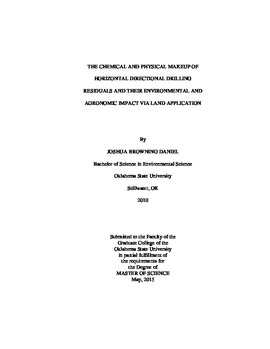| dc.contributor.advisor | Penn, Chad | |
| dc.contributor.author | Daniel, Joshua Browning | |
| dc.date.accessioned | 2016-04-15T21:49:19Z | |
| dc.date.available | 2016-04-15T21:49:19Z | |
| dc.date.issued | 2015-05-01 | |
| dc.identifier.uri | https://hdl.handle.net/11244/33408 | |
| dc.description.abstract | There is a growing need for economical disposal of spent horizontal directional drilling (HDD) fluid, or HDD residuals. This study was conducted to physically and chemically characterize HDD residuals from a wide geographic area, and determine if land application is a viable option for disposal. Fifty-eight HDD residuals were received from throughout the U.S. Residuals were analyzed for potential nutrients, trace metals, and salts. Two separate field studies were conducted to study the effects of six application rates of HDD residuals on soil properties and plants. Residuals were applied to established grass plots and to bare soil plots. Forage yield and percent cover were measured respectively. Soil samples were taken at 7, 30, and 90 days after application, and analyzed for potential nutrients, salts, and water soluble metals. After chemical and physical characterization of 58 samples, no trace metals concentrations exceeded EPA Part 503 ceiling for exceptional quality biosolids. Nutrient concentrations were negligible. Salt concentrations were variable. In the established grass field study, there was no significant difference in yield over all treatments. For the bare soil field study, there was no significant difference in percent cover at day 30. At day 63 percent cover at the lowest application rate was significantly higher than the control and all other treatments while percent cover at the highest application rate was significantly lower than the control. Electrical conductivity, pH, SAR, and Mehlich-3 Ca were significant over application rates. Of the 58 residual samples received, nothing was chemically limiting land application. Total solids was the most limiting factor. Land applying HDD residuals at the lowest rate possibly promotes seed germination and application at the highest rate potentially hinders it. Results suggest that land application is a viable option for disposal. However, soil and/or cuttings from the borehole are a large portion of HDD residuals; so boring through a contaminated site could result in a contaminated residual, possibly limiting its potential to be land applied. In this scenario, testing the residual prior to application is recommended. Tillage is advised when applying a residual with a high EC and/or SAR to a bare soil. | |
| dc.format | application/pdf | |
| dc.language | en_US | |
| dc.publisher | Oklahoma State University | |
| dc.rights | Copyright is held by the author who has granted the Oklahoma State University Library the non-exclusive right to share this material in its institutional repository. Contact Digital Library Services at lib-dls@okstate.edu or 405-744-9161 for the permission policy on the use, reproduction or distribution of this material. | |
| dc.title | Chemical and Physical Makeup of Horizontal Directional Drilling Residuals and Their Environmental and Agronomic Impact via Land Application | |
| dc.type | text | |
| dc.contributor.committeeMember | Penn, Chad | |
| dc.contributor.committeeMember | Zahng, Hailin | |
| dc.contributor.committeeMember | Warren, Jason | |
| osu.filename | Daniel_okstate_0664M_13936.pdf | |
| osu.accesstype | Open Access | |
| dc.description.department | Plant & Soil Sciences | |
| dc.type.genre | Thesis | |
